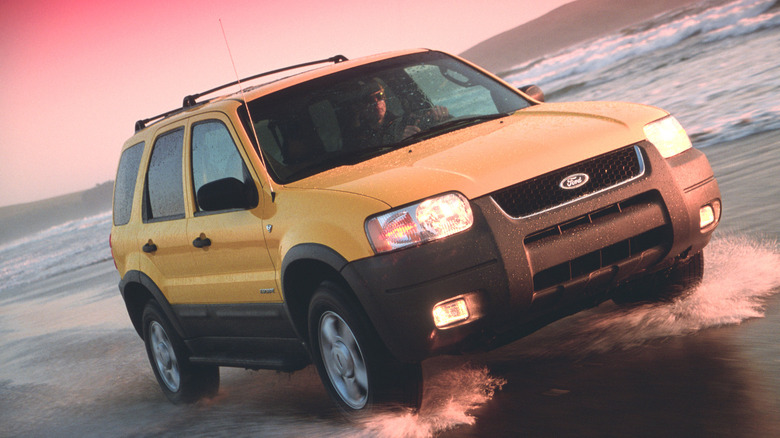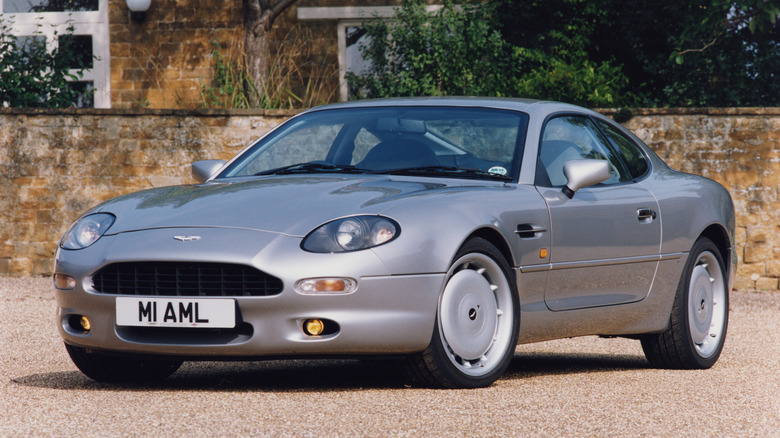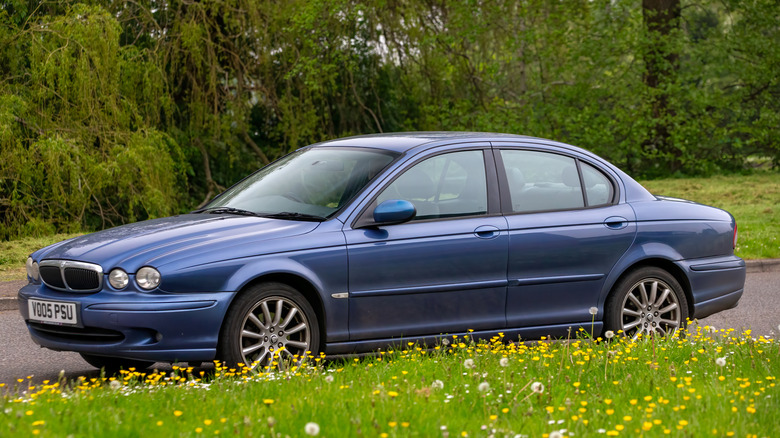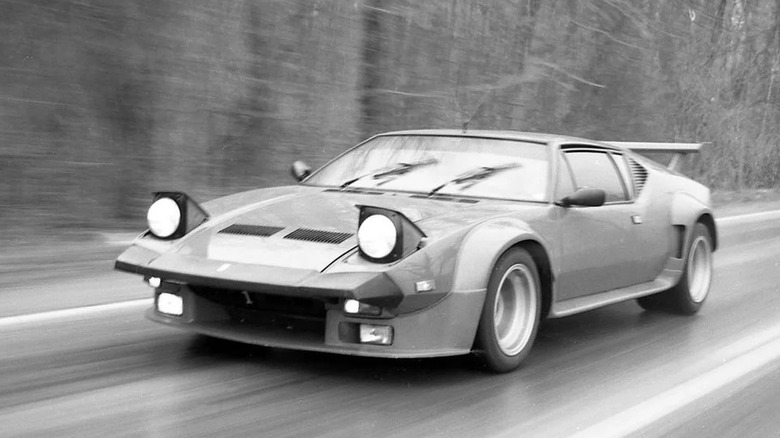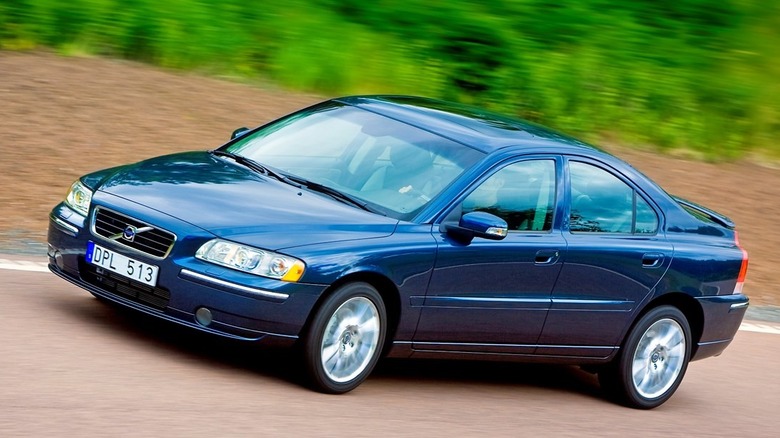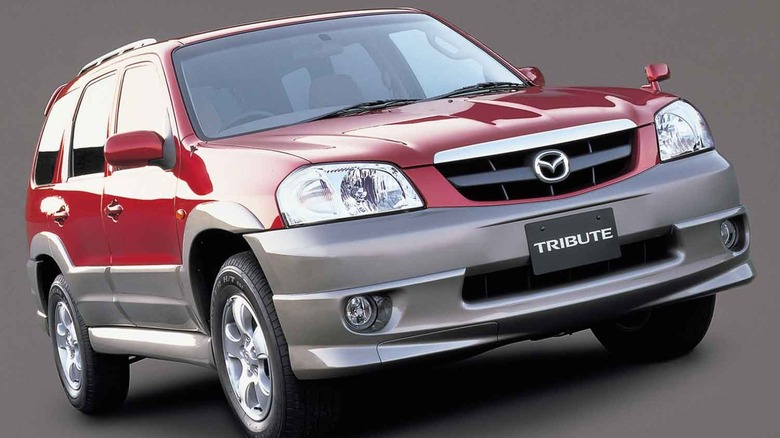5 Car Brands You Might Not Know Ford Owned
Ford represents one of the longest-lived and most prolific automakers worldwide, selling its vehicles to global audiences across multiple branches. For the most part, we're all familiar with these: brands like Ford Canada, Ford Europe, Ford Australia, Mercury, Lincoln, and so on. But underneath the regular marques lies a whole system of shares, investments, badge-engineering, and more that enabled Ford to not only spread its influence across continents, but share and receive technology from foreign and internal companies.
Today, Ford owns a broad and diverse array of names, including over a dozen internal brands, and many more externals. And if you trace its lineage back to the early days, this number only grows more and more. Many of these companies no longer exist or changed substantially, such as internally-designated brands like Continental (the development of the Lincoln Continental), Monarch, Merkur, and Edsel; along with oddball names like Fordson, AC Cars, and Think Global.
Naturally, a list of just five of these brands is nowhere near exhaustive, but it does paint a picture for what Ford looked for when it acquired said companies. Each one has a specific and often nuanced reason for sharing a partnership with Ford, with who-knows how many more partnerships fallen by the wayside to accompany this selection. For instance, Ford once almost purchased Ferrari in 1963, owing to the companies' mutual racing rivalry, before Fiat undercut Ford and purchased Ferrari itself. Let's dive in and explore some more historical fun facts from companies you might not have realized Ford had in its pocket.
Aston Martin
Ford owned Aston Martin between 1994 and 2007. The British luxury company is perhaps best known for producing high-quality, handmade vehicles with a reputation for being screen queens, with James Bond's DB5 the most obvious example. However, despite their price point, Aston Martins were historically loathed for being unreliable, though that picture's largely positively changed in modern years.
Now comes the question: why would Ford be interested in a specialist British manufacturer? The simple answer is exclusivity. Walter Hayes, vice-president of Ford of Europe, purchased 75% of Aston Martin's shares in 1987, which turned into full ownership about seven years later. Meanwhile, Ford marketed Aston Martin alongside other luxury marques under its brand, such as Land Rover and Lincoln.
Being that Aston Martin was primarily a small-volume company with substantial financial issues throughout the latter half of the 20th century and Ford was looking to diversify into the luxury market, these mutual interests brought both companies together and allowed Aston to produce and sell a decent number of machines. But the financial tides began to turn, and Ford sold off several of its luxury marques in the mid-late 2000s prior to the 2008 financial crisis. This decision was both remarkably judicious and well-timed, with Aston Martin sold to a private consortium comprised of David Richards, Investment Dar, and Adeem Investment. In total, Ford either partially or wholly-owned Aston Martin for almost 20 years, overseeing successful machines such as the DB7 and the Vantage featured in James Bond's "Die Another Day." Aston Martin remains privately-owned today, though with different names and investors making up the current consortium.
Jaguar
Speaking of British sports cars, Jaguar shared a story with Aston Martin regarding its acquisition: namely, Ford purchased this company for $2.38 billion in 1989, acquiring what was known at the time as an automaker that produced poor-quality, low-volume, unreliable machines. This all came at a time in which other American automakers were scooping up these foreign luxury automakers with regularity. For instance, Chrysler owned both Maserati and Lamborghini by 1987 and GM had developed its relationship with Lotus, to the tune of a $25 million investment. Not to be outdone, Ford set about establishing itself in a more premium-oriented market, diversifying with the aid of the waning British company, formerly owned by British Leyland.
Jaguar's quality control was nowhere near acceptable by Ford's standards at the time, and so both companies sought reformation in their respective fields. For Ford, Jaguar granted it an easy means to compete on an even playing field with other European juggernauts like Mercedes and BMW, as well as diversify its native British audience for Ford of Europe. Meanwhile, Jaguar experienced a renaissance under Ford, producing numerous new models and substantially updating its quality levels.
However, these facts downplayed the reality of the situation; that is, Jaguar was hemorrhaging money — and that accounts for the badge-engineered cars, such as the X-Type and S-Type, which shared platforms with Ford models. But by 2008, Jaguar had lost Ford $15 billion in two years alone, and Ford ultimately sold the company along with Land Rover to Tata Motors in India prior to the financial crisis; Jaguar Land Rover remains a wholly-owned subsidiary of Tata Motors. These days, it's probably best-known for its frankly cringeworthy rebranding efforts.
De Tomaso
Back in the 1970s, De Tomaso was essentially the closest car one could purchase that was a poor man's Ferrari or Lamborghini. The company bears the name of its founder, Alejandro de Tomaso, an Argentine businessman and racing driver. He acquired numerous coachbuilding firms over the years, such as Ghia, Vignale, and later even Maserati before it fell to Chrysler's hands. Meanwhile, sports cars grew more exotic and experimental throughout the late-1960s, with cars like the CERV II and its predecessors threatening a mid-engined Corvette that didn't ultimately manifest until the model's current generation. Ford had virtually nothing to compete with at the time, apart from the Mustang platform; an exotic car, however, was a long shot.
Hence, in 1970, Ford purchased a majority stake in De Tomaso for the purpose of developing a mid-engined exotic car powered by a Ford engine. Italian sports cars were expensive, finicky, and rare, so building one powered with American durability was hoped to be a match made in Heaven: enter the De Tomaso Pantera, powered by a 351 Cleveland mated to a ZF 5-speed transmission. This marked the most popular and well-known De Tomaso produced under Ford's ownership, with over 7,000 units produced over the course of 23 years –though De Tomaso produced various other models that have been long-forgotten by many.
The partnership only lasted until 1973, but it ended due to circumstance rather than either Ford or De Tomaso. Namely, the 1973 Oil Crisis ultimately killed the brand partnership, with Ford backing out due to tightening emissions restrictions. De Tomaso as a brand still produces specialist cars, its most recent concept slated for production being the P72.
Volvo
Volvo, best-known in the passenger car community for its universally-beloved line of sedans nicknamed the Swedish Brick, fell under the Ford umbrella between 1999 and 2010. While the name doesn't carry as much prestige as either Aston Martin or Jaguar, the decision was nevertheless taken with similar underlying motivations — namely, expanding into the European luxury market. This acquisition granted Ford access to the coveted engineering and safety expertise held by the Swedish conglomerate, which has infamously been obsessed with safety innovations for decades. This is the company which crafted landmark developments in the industry, such as the three-point seatbelt in 1959 that it released to the public domain. Such a skill set proved invaluable to Ford's restructuring for the Europe-centric market in the 2000s.
Much like Jaguar, Volvo was also setting its sights on German luxury giants at the time but lacked the financial capital to stand toe-to-toe with a firm like Mercedes. The combination of Volvo's expertise in building budget-conscious premium models with advanced features, plus Ford's bankroll, helped solidify the presence of both companies across Europe, mainly in Volvo's native Scandinavia. Moreover, under Ford's leadership, Volvo introduced a number of new models, such as the S60 sedan, XC60 crossover, and XC90 SUV with technology such as whiplash protection, active suspension, and advanced traction control systems. Sadly, Volvo's fate also mirrored Jaguar's, namely failure to hit its goalposts. Ford ultimately sold the brand in 2010 to Chinese juggernaut Geely, which owns Volvo to this day — among many other brands you might not know fall under its umbrella.
Mazda
The longstanding former partnership between Ford and Mazda represents by far one of the most prolific collaborative efforts between two manufacturers involved in otherwise separate vehicle lines, with its heritage tracing back to the 1950s. Back then, Japanese import cars were viewed as cheap imported junk; the Subaru 360, for example, was poorly-suited to American roads and wound up a commercial failure. Mazda faced an uphill battle when it was first introduced to American audiences in the 1970s, though it held certain aces up its sleeve, most notably the Wankel powerplant that earned it initial success.
The main problem with Wankel engines, however, is that they're thirsty. That's not much of an issue in the late-1960s, but it became a substantial obstacle once the 1973 Oil Crisis struck. American sales plummeted, leading Mazda into near-financial ruin stateside. In an effort to stay solvent, Mazda entered a long and fruitful partnership with Ford, which began with the humble Courier pickup and lasted until 2015. Following the subsequent 1979 Oil Crisis, Ford and Mazda solidified this partnership to the tune of a 25% equity interest.
Mazda's expertise in producing compact, mass-produced vehicles carried Ford through the entirety of the Malaise Era, jointly producing a wide array of models over the course of the companies' over 40 years of partnership. Some examples include the Ford Courier/Mazda Pickup, Ford Escape/Mazda Tribute, and Ford Festiva/Mazda 121. Generally, if it's the 1980s-2000s and not a Mustang or F-series, chances are it holds a good amount of Mazda DNA. Ford ultimately sold its shares in 2015, leaving Mazda a largely independent company, a position it retains today.
